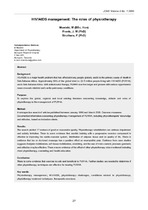| dc.contributor.author | Munishi, M. | |
| dc.contributor.author | Frantz, Jose M. | |
| dc.contributor.author | Struthers, Patricia | |
| dc.date.accessioned | 2017-05-02T13:23:08Z | |
| dc.date.available | 2017-05-02T13:23:08Z | |
| dc.date.issued | 2009 | |
| dc.identifier.citation | Munishi, M. et al. (2009). HIV/AIDS management: the roles of physiotherapy. Journal of Community and Health Sciences, 4(1): 27-35 | en_US |
| dc.identifier.issn | 1990-9403 | |
| dc.identifier.uri | http://hdl.handle.net/10566/2774 | |
| dc.identifier.uri | http://jchs.epubs.ac.za/index.php/jchs/article/view/44/38 | |
| dc.description.abstract | BACKGROUND: HIV/AIDS is a major health problem that has affected many people globally and it is the primary
cause of death in Sub-Saharan Africa. Approximately 68% of the global total i.e. 22.5 million
people living with HIV/AIDS (PLWHA) are in Sub-Saharan Africa. With antiretroviral therapy, PLWHA
now live longer and present with various opportunistic neuro-musculo-skeletal and cardio-pulmonary
conditions.
PURPOSE: To explore the global, regional and local existing literature concerning knowledge,
attitude and roles of physiotherapy in the management of PLWHA.
METHOD: A retrospective search of articles published between January 1990 and March 2008. Outcome measures:
Documented information concerning physiotherapy management of PLWHA, including physiotherapists'
knowledge and attitudes, based on inclusion criteria.
RESULTS: The search yielded 17 reviews of good or reasonable quality. Physiotherapy rehabilitation can
address impairment and activity limitation. There is some evidence that aerobic training with a
progressive exercise component is effective in improving the cardio-vascular system, distribution
of adipose tissue and on quality of life. There is evidence that ice or dry-towel massage has a
positive effect on neuropathic pain. Evidence from case studies suggests that joint mobilization,
soft tissue mobilization, stretching, and the use of micro-current, pressure garments and orthotics
may be effective. There was no evidence of the effect of other physiotherapy roles mentioned
including chest physiotherapy, counseling and health education.
CONCLUSION: There is some evidence that exercise is safe and beneficial to PLWHA. Further studies are needed to
determine if other physiotherapy techniques are effective for treating PLWHA. | en_US |
| dc.language.iso | en | en_US |
| dc.publisher | University of the Western Cape | en_US |
| dc.rights | This journal provides immediate open access to its content on the principle that making research freely available to the public supports a greater global exchange of knowledge. | |
| dc.subject | Physiotherapy management | en_US |
| dc.subject | HIV/AIDS | en_US |
| dc.subject | Physiotherapy challenges | en_US |
| dc.subject | Treatment | en_US |
| dc.subject | Exercises | en_US |
| dc.title | HIV/AIDS management: the roles of physiotherapy | en_US |
| dc.type | Article | en_US |
| dc.privacy.showsubmitter | FALSE | |
| dc.status.ispeerreviewed | TRUE | |

